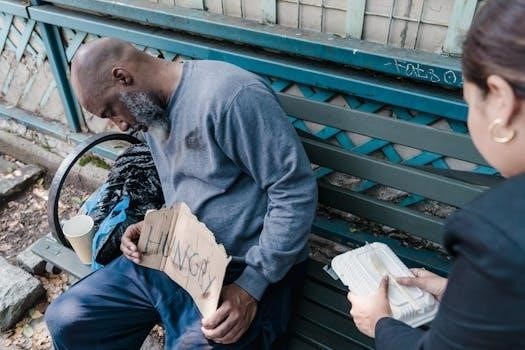Jonathan Kozol’s 1991 work, Savage Inequalities, critically examines the American educational system. The book exposes the stark disparities between schools, especially concerning funding and resources, revealing inequalities between different classes and races.
Overview of Jonathan Kozol’s Book
Jonathan Kozol’s Savage Inequalities⁚ Children in America’s Schools, published in 1991, serves as a powerful indictment of the American public education system. Through meticulous observation and firsthand accounts, Kozol unveils the stark contrasts between affluent suburban schools and their impoverished urban counterparts. The book meticulously documents the systemic inequalities, highlighting the gross disparities in funding, resources, and facilities. It exposes how these inequities perpetuate a cycle of disadvantage for students based on their socioeconomic backgrounds and racial identities. Kozol’s work is not merely an academic study but a passionate call for social justice, urging readers to confront the uncomfortable truths about the educational landscape in the United States. His narrative style brings a human element to the statistics, making it a compelling read. The impact of the book is rooted in the juxtaposition of privilege and poverty within the American educational system.

Core Themes of Savage Inequalities
Kozol’s work emphasizes disparities in school funding, racial and class segregation, and the detrimental impact on students’ opportunities. These themes highlight systemic educational inequalities that affect many students.
Disparities in School Funding
A central theme in Savage Inequalities is the glaring disparities in school funding across different districts. Kozol meticulously documents how wealthier communities often boast significantly higher per-pupil expenditures than poorer ones. This funding gap directly translates into vastly different educational experiences. Schools in affluent areas frequently have state-of-the-art facilities, abundant resources, and lower student-to-teacher ratios. Conversely, schools in impoverished districts often struggle with dilapidated buildings, outdated textbooks, and overcrowded classrooms. These financial inequalities perpetuate a cycle of disadvantage, denying many students access to an equal educational opportunity. Such unequal funding highlights systemic inequities deeply embedded within the American public school system. Kozol argues that these discrepancies are not accidental but rather the consequence of deliberate policy choices.
Racial and Class Segregation in Education
Savage Inequalities also underscores the pervasive issue of racial and class segregation within the American educational landscape. Kozol reveals how residential segregation patterns often lead to de facto segregation in schools, where predominantly white, affluent students attend well-funded institutions, while minority and low-income students are relegated to under-resourced schools. This segregation not only perpetuates educational inequalities but also hinders social mobility. The book highlights the stark contrast between schools with diverse student populations and those that are racially and economically homogenous. Kozol argues that this segregation is not merely a byproduct of demographic trends but also a result of discriminatory policies and practices. The lack of integration in schools further entrenches societal divisions and limits opportunities for marginalized communities to advance.
Impact on Students’ Opportunities
The disparities highlighted in Savage Inequalities have a profound and detrimental impact on students’ opportunities. Children attending underfunded schools often lack access to essential resources, such as up-to-date textbooks, computers, science labs, and qualified teachers. This lack of resources creates a significant disadvantage, hindering their academic progress and limiting their future educational and career prospects. Furthermore, the inadequate facilities and overcrowded classrooms contribute to a less conducive learning environment, which can affect students’ motivation and engagement. The book emphasizes that these inequalities are not only unjust but also undermine the promise of equal opportunity, trapping students from disadvantaged backgrounds in a cycle of poverty and limited potential. The impact is not merely academic; it shapes their entire life trajectory.

Kozol’s Observations and Findings
Kozol’s work details his observations in various school systems, notably East St. Louis. His findings reveal stark contrasts between wealthy and impoverished schools, highlighting severe resource inequities.
East St. Louis School System
Kozol’s detailed examination of the East St. Louis school system provides a grim portrayal of educational neglect. He documents the dilapidated conditions of the schools, including crumbling infrastructure, a lack of essential resources, and an absence of basic supplies. Classrooms often lacked sufficient textbooks and materials, leaving teachers struggling to provide adequate instruction. The facilities themselves were in disrepair, with leaky roofs, inadequate heating, and a general sense of decay. Kozol’s observations reveal a system severely underfunded, where children were forced to learn in conditions that were not only substandard but also physically detrimental. This environment directly impacted students’ ability to learn and thrive, further perpetuating cycles of poverty and inequality. The situation in East St. Louis underscores the profound impact of systemic neglect on educational outcomes. He uses this example to illustrate how funding inequities create vastly different realities for students in affluent and impoverished areas.
Contrasting Rich and Poor Schools
Kozol’s analysis starkly contrasts the conditions of wealthy suburban schools with those in impoverished urban areas, highlighting the profound inequities in the American education system. He describes affluent schools with well-maintained facilities, ample resources, and advanced technology, where students benefit from smaller class sizes and a wide array of extracurricular activities. These schools often have well-stocked libraries, state-of-the-art science labs, and abundant sports facilities. In contrast, schools in poorer districts suffer from overcrowding, crumbling infrastructure, and a severe lack of essential resources. Kozol emphasizes the vast differences in funding, teacher quality, and the overall educational environment, demonstrating how these disparities contribute to vastly different academic outcomes and life opportunities for students, reinforcing a cycle of inequality. The contrast serves as a harsh indictment of a system that perpetuates advantages for some while denying basic necessities to others.

Critical Reception and Analysis
Kozol’s Savage Inequalities received both praise and criticism. Many lauded its exposure of educational disparities, while others questioned its methodology and conclusions, leading to debates about school funding.
Positive Reviews and Impact
Jonathan Kozol’s Savage Inequalities garnered significant positive attention for its unflinching portrayal of the stark realities within America’s public school system. Many reviewers commended Kozol for his passionate and evocative writing style, which brought the human cost of educational disparities to the forefront. The book was praised for its meticulous documentation of the contrasting conditions between affluent and impoverished schools, effectively highlighting the systemic inequalities faced by marginalized communities. Critics acknowledged the book’s powerful ability to stir public consciousness and spark national conversations about educational justice. It was also credited with influencing educators, policymakers, and activists, driving efforts toward school reform and a more equitable distribution of resources; Savage Inequalities became a catalyst for numerous discussions, workshops, and initiatives aimed at addressing the deep-seated issues within the American educational landscape, leaving a lasting impact on the field.
Criticisms and Counterarguments
While Savage Inequalities received widespread acclaim, it also faced criticisms and counterarguments. Some critics argued that Kozol’s approach, while emotionally powerful, lacked a rigorous quantitative analysis and relied too heavily on anecdotal evidence. They contended that the book did not fully consider the complex factors contributing to educational disparities, such as family dynamics, community resources, and cultural influences. Other critics suggested that Kozol’s focus on funding disparities overlooked other crucial aspects of educational quality, such as curriculum design, teacher effectiveness, and parental involvement. Furthermore, some questioned the feasibility of Kozol’s proposed solutions, arguing that they were overly simplistic and did not account for the practical challenges of implementing systemic change. These counterarguments aimed to provide a more nuanced understanding of the issue and challenged the dominant narrative presented in the book, prompting further debate on educational reform.
Relevance and Legacy
Savage Inequalities remains relevant, highlighting ongoing educational inequities. The book has influenced discussions about school funding and reform, bringing attention to the lasting impact of racial and class disparities.
Ongoing Issues of Inequality
Despite decades passing since the publication of Savage Inequalities, the issues of educational inequality highlighted by Jonathan Kozol persist. Disparities in school funding continue to plague the American education system, with wealthier districts often possessing significantly more resources than those serving poorer communities. This directly impacts the quality of education, access to advanced courses, and the availability of essential learning materials. Racial and class segregation remains a stark reality in many areas, perpetuating a cycle of disadvantage for students in underserved schools. The consequences are far-reaching, affecting students’ college prospects, career opportunities, and their overall life trajectories. Kozol’s work serves as a reminder that equal opportunity in education is still a goal yet to be fully realized, prompting continued action towards systemic change.
Influence on Education Reform
Jonathan Kozol’s Savage Inequalities has significantly impacted discussions and initiatives aimed at education reform. The book’s stark portrayal of educational disparities galvanized public awareness and spurred calls for more equitable funding models. Kozol’s work helped to shape the narrative around the need for systemic change to address the deep-seated inequalities within American public schools. The book has also influenced policy debates, with many reformers and advocates using his findings to support their proposals for greater resource allocation to underserved schools. Moreover, Savage Inequalities has inspired educators and activists to work towards creating more inclusive learning environments and to challenge the structures that perpetuate educational disparities. It continues to be a relevant text in the fight for equitable education.

Additional Information
Savage Inequalities uses community cultural wealth lens to highlight resistance strategies of communities facing oppression. Reauthoring efforts aim to counter dominant narratives. Kozol’s writing style is passionate and direct.
Community Cultural Wealth Lens
The community cultural wealth lens offers a crucial perspective when analyzing Savage Inequalities. This framework shifts the focus from a deficit-based view of marginalized communities to recognizing the various forms of capital they possess. These assets include aspirational, linguistic, familial, social, navigational, and resistant capital. Instead of solely examining what under-resourced schools lack, this lens illuminates the strengths, resilience, and rich cultural knowledge that students and their communities bring. It also counters the narrative that blames individuals for systemic failures, emphasizing that communities of color actively use their unique cultural capital to navigate and resist educational inequalities. This perspective helps to understand the deeper societal issues highlighted by Kozol’s work, emphasizing the need for equitable and culturally responsive educational practices.
Reauthoring Savage Inequalities
The concept of “Reauthoring Savage Inequalities” involves a critical re-examination of the issues presented in Jonathan Kozol’s book through the lens of contemporary educational contexts. This endeavor brings together scholars, educators, and students to challenge the dominant narratives of urban education. These efforts aim to move beyond simply acknowledging the problems to actively seeking solutions. Reauthoring involves using a community cultural wealth perspective, to celebrate the strengths and knowledge of marginalized communities while dismantling systemic barriers. It is about fostering collaborative and participatory approaches that center the experiences of those most affected by inequality. By actively engaging with these issues, we can strive towards a more just and equitable education system, building upon the vital work initiated by Kozol.
Kozol’s Writing Style
Jonathan Kozol’s writing in Savage Inequalities is characterized by its impassioned and often indignant tone. He employs vivid descriptions and personal anecdotes to portray the stark realities of inequality in American schools, making the experiences of students and teachers palpable to the reader. His style is marked by a direct, almost journalistic approach, where he presents facts and figures alongside powerful narratives. This combination serves to both inform and emotionally engage the reader. Kozol avoids academic jargon, making his work accessible to a wide audience, and he frequently uses a comparative technique to starkly contrast the conditions of wealthy and impoverished schools. This approach effectively highlights the systemic nature of the inequalities he documents. His work is ultimately a call to action, compelling readers to confront the injustice within the education system.
